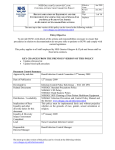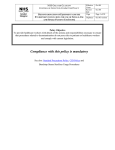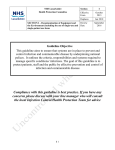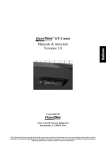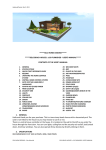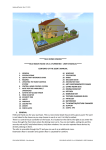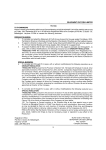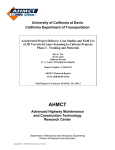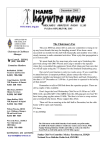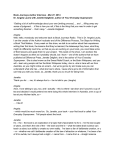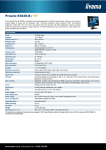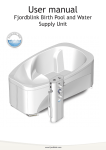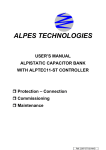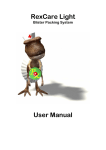Download infection control policy - NHS Greater Glasgow and Clyde
Transcript
NHS GREATER GLASGOW & CLYDE CONTROL OF INFECTION COMMITTEE POLICY DECONTAMINATION OF EQUIPMENT AND THE ENVIRONMENT (INCLUDING THE USE OF SINGLE-USE AND SINGLE-PATIENT USE ITEMS) AN ELEMENT OF STANDARD PRECAUTIONS Page 1 of 13 Effective From Review date Version November 2011 November 2014 4 The most up-to-date version of this policy can be viewed at the following website: www.nhsggc.org.uk/infectioncontrol Policy Objective To provide Healthcare Workers (HCWs) with details of the actions and responsibilities necessary to ensure that procedures in relation to decontamination do not pose risks to patients or HCWs and comply with current legislation. This policy applies to all staff employed by NHS Greater Glasgow & Clyde and locum staff on fixed term contracts. KEY CHANGES FROM THE PREVIOUS VERSION OF THIS POLICY • New category for CJD risk added Document Control Summary Approved by and date Board Infection Control Committee 21 November 2011 Date of Publication 22 November 2011 Developed by Related Documents Infection Control Policy Sub-Group - 0141 211 2526 NHSGGC Creutzfeldt-Jakob Disease (CJD) Policy NHSGGC Hand Hygiene Policy NHSGGC Standard Precautions Policy NHSGGC SOP Cleaning of Near Patient Healthcare Equipment NHSGGC Infection Prevention and Control Policy Manual and the Internet www.nhsggc.org.uk/infectioncontrol This policy must be implemented fairly and without prejudice whether on the grounds of race, gender, sexual orientation or religion. November 2011 Distribution / Availability Implications of Race Equality and other diversity duties for this document Equality & Diversity Impact Assessment Completed Lead Responsible Director/Manager Lead Infection Control Nurse North East Board Infection Control Manager The most up-to-date version of this policy can be viewed at the following website: www.nhsggc.org.uk/infectioncontrol NHS GREATER GLASGOW & CLYDE CONTROL OF INFECTION COMMITTEE POLICY DECONTAMINATION OF EQUIPMENT AND THE ENVIRONMENT (INCLUDING THE USE OF SINGLE-USE AND SINGLE-PATIENT USE ITEMS) AN ELEMENT OF STANDARD PRECAUTIONS Page 2 of 13 Effective From Review date Version November 2011 November 2014 4 The most up-to-date version of this policy can be viewed at the following website: www.nhsggc.org.uk/infectioncontrol Contents 1. Responsibilities ....................................................................................................................... 3 2. Introduction ............................................................................................................................. 4 3. The use of Single-Use and Single-Patient Use Equipment ..................................................... 4 4. Definitions............................................................................................................................... 4 5. Re-usable Medical Devices (Re-usable devices are NEVER marked single-use).................. 5 5.1. Risk Categorisation for the Decontamination of Medical Devices................................. 5 5.2. CJD.................................................................................................................................. 6 5.3. Surgical instruments used on patients with or suspected of having CJD/ vCJD............. 6 5.4. Decontaminating equipment ........................................................................................... 7 6. General Good Practice Guidelines .......................................................................................... 7 6.1. Training ........................................................................................................................... 7 7. Symbols used on medical packaging and their meanings ....................................................... 8 8. Disinfectants............................................................................................................................ 9 8.1. Personal Protective Equipment (PPE)............................................................................. 9 8.2. Spillages on Carpets ........................................................................................................ 9 8.3. Body Fluid Spillage Procedure ..................................................................................... 10 8.4. Formulae for disinfectant calculations .......................................................................... 11 9. Adverse Incident Reporting (Medical Devices).................................................................... 11 10. Equipment Sent for Service or Repair................................................................................... 11 11. Audit...................................................................................................................................... 12 12. References & Bibliography................................................................................................... 13 The most up-to-date version of this policy can be viewed at the following website: www.nhsggc.org.uk/infectioncontrol NHS GREATER GLASGOW & CLYDE CONTROL OF INFECTION COMMITTEE POLICY DECONTAMINATION OF EQUIPMENT AND THE ENVIRONMENT (INCLUDING THE USE OF SINGLE-USE AND SINGLE-PATIENT USE ITEMS) AN ELEMENT OF STANDARD PRECAUTIONS Page 3 of 13 Effective From Review date Version November 2011 November 2014 4 The most up-to-date version of this policy can be viewed at the following website: www.nhsggc.org.uk/infectioncontrol 1. Responsibilities Healthcare Workers (HCW) • • • Follow this policy. Attend appropriate training. Report to supervisor/ manager when they are unable to follow the policy or if they think there is a problem/ issue with equipment. Clinical Managers/ Senior Charge Nurses (SCN) • • • Ensure HCWs involved in implementing this policy are trained to do so. Ensure HCWs have access to and follow this policy. Seek advice from ICT regarding the correct method of decontamination of equipment if required. Managers • Support Clinical Managers/ SCNs in implementing this policy. Infection Control Team (ICT) • • • Provide teaching opportunities on the implementation of this policy. Act as a resource for guidance with regards to decontamination of blood and body fluid spills. Keep this policy up-to-date. Sterile Services Department (SSD) Manager, Estates Manager, Procurement Managers • • Liaise with the ICTs on matters relating to decontamination. Seek the advice of ICTs before purchasing new items that require reprocessing and cannot be autoclaved. Medical Physics Technicians • Report adverse incidents to appropriate authorities. The most up-to-date version of this policy can be viewed at the following website: www.nhsggc.org.uk/infectioncontrol NHS GREATER GLASGOW & CLYDE CONTROL OF INFECTION COMMITTEE POLICY DECONTAMINATION OF EQUIPMENT AND THE ENVIRONMENT (INCLUDING THE USE OF SINGLE-USE AND SINGLE-PATIENT USE ITEMS) AN ELEMENT OF STANDARD PRECAUTIONS Page 4 of 13 Effective From Review date Version November 2011 November 2014 4 The most up-to-date version of this policy can be viewed at the following website: www.nhsggc.org.uk/infectioncontrol 2. Introduction This policy details the actions necessary for the safe use of medical devices and appropriate use of disinfectants in NHS Greater Glasgow & Clyde to minimise the risk of healthcare associated infection (HAI). Medical devices can pose significant hazards to patients if they are reprocessed inadequately or incorrectly. Additionally, risks can arise from equipment that should not be reprocessed, i.e. single-use items. All HCWs involved in the use of medical devices must be aware of their role and responsibilities towards patient safety and infection control. 3. The use of Single-Use and Single-Patient Use Equipment Prior to use, packaging must be checked for single-use markings and decontamination instructions. Items marked “Single-Use” must be used once, on one patient, and discarded as clinical waste. Items marked “Single-Patient-Use” may be decontaminated and only re-used on the same patient provided the manufacturer’s instructions on decontamination and re-use are followed. See Section 7 for the Symbol for Single-Use. 4. Definitions • Decontamination: the combination of processes, including cleaning, disinfection and/ or sterilisation, used to render a re-usable item safe for further use • Cleaning: is the process which physically removes large numbers of micro-organisms and the organic matter on which they thrive • Disinfection: is the reduction of the number of viable micro-organisms on a device to a level previously specified as appropriate for its intended further handling or use • Sterilisation: a process which if specified conditions are met, renders a device sterile, i.e. free from all micro-organisms and spores. (The theoretical probability of there being a viable micro-organism present on the device shall be equal or less than 1 in a million (BS EN 556-2 2003). The most up-to-date version of this policy can be viewed at the following website: www.nhsggc.org.uk/infectioncontrol NHS GREATER GLASGOW & CLYDE CONTROL OF INFECTION COMMITTEE POLICY DECONTAMINATION OF EQUIPMENT AND THE ENVIRONMENT (INCLUDING THE USE OF SINGLE-USE AND SINGLE-PATIENT USE ITEMS) AN ELEMENT OF STANDARD PRECAUTIONS Page 5 of 13 Effective From Review date Version November 2011 November 2014 4 The most up-to-date version of this policy can be viewed at the following website: www.nhsggc.org.uk/infectioncontrol 5. Re-usable Medical Devices (Re-usable devices are NEVER marked single-use) A medical device is any piece of equipment that is used on a patient. It includes all equipment, e.g. tourniquets, blood pressure cuffs as well as surgical instruments. Different medical devices require different levels of decontamination. The level of decontamination depends on: • where the device has been used • the type and amount of contamination • the complexity of the device This necessitates a risk assessment before reprocessing begins. There are three categories of risk to be considered for the equipment, the procedure and the patient. They are explained in: • Risk Categorisation for the Decontamination of Medical Devices. See 5.1 • Surgical instruments used on patients with or suspected of having CJD/ vCJD. See 5.3. 5.1. Risk Categorisation for the Decontamination of Medical Devices Risk Category Description High-Risk Items in close contact with a break in the Sterilisation – Decontamination to be skin or mucous membrane or introduced undertaken in a specialist facility, e.g. into a sterile body area. Sterile Services Department. Items in contact with intact skin, Sterilisation or disinfection required. particularly after use on infected patients Decontamination to be undertaken in a or prior to use on immuno-compromised specialist facility, e.g. Sterile Services patients, or items in contact with mucous Department or ICT Approved Area. Intermediate Risk Recommendation membranes or body fluids. Low Risk Items in contact with healthy skin or not Decontamination – may be undertaken in contact with patient. in the clinical area. The most up-to-date version of this policy can be viewed at the following website: www.nhsggc.org.uk/infectioncontrol NHS GREATER GLASGOW & CLYDE CONTROL OF INFECTION COMMITTEE POLICY DECONTAMINATION OF EQUIPMENT AND THE ENVIRONMENT (INCLUDING THE USE OF SINGLE-USE AND SINGLE-PATIENT USE ITEMS) AN ELEMENT OF STANDARD PRECAUTIONS Page 6 of 13 Effective From Review date Version November 2011 November 2014 4 The most up-to-date version of this policy can be viewed at the following website: www.nhsggc.org.uk/infectioncontrol 5.2. CJD There are Technical Requirements for Decontamination for specific instruments in relation to CJD. The rationale for additional precautions in the decontamination of equipment for instruments potentially contaminated with CJD is that normal steriliser temperatures do not inactivate the prion, which is thought to cause CJD. For further information please refer to the NHSGGC CJD Policy http://www.nhsggc.org.uk/content/default.asp?page=s708_3. 5.3. Surgical instruments used on patients with or suspected of having CJD/ vCJD Risk Category Patient suspected of having CJD Action Quarantine instruments in designated box. Comment See CJD Policy Consider the use of single-use disposable equipment wherever possible. Patient in high-risk group: • patients with antithrombin deficiency, haemophilia or other familial bleeding disorders • recipients of growth hormones or gonadotrophin treatment before 1986 in the UK or at any time whilst abroad • recipients of human dura mater grafts • patients with a family history of familial CJD • patients who have been contacted by public health and told that they are at risk of CJD • patients who have had multiple transfusions - more than 50 units of blood or blood components or received blood or blood components on more than 20 occasions See If possible decontaminate and CJD Policy retain for the use of the named patient, e.g. endoscopes. Patient diagnosed as having CJD If possible decontaminate and See retain for the use of the named CJD Policy patient, e.g. endoscopes. All other instruments should be sent for incineration in the yellow waste stream. Consider the use of single-use wherever disposable equipment possible. All other instruments should be sent for incineration in the yellow waste stream. Consider the use of single-use wherever disposable equipment possible. The most up-to-date version of this policy can be viewed at the following website: www.nhsggc.org.uk/infectioncontrol NHS GREATER GLASGOW & CLYDE CONTROL OF INFECTION COMMITTEE POLICY DECONTAMINATION OF EQUIPMENT AND THE ENVIRONMENT (INCLUDING THE USE OF SINGLE-USE AND SINGLE-PATIENT USE ITEMS) AN ELEMENT OF STANDARD PRECAUTIONS Page 7 of 13 Effective From Review date Version November 2011 November 2014 4 The most up-to-date version of this policy can be viewed at the following website: www.nhsggc.org.uk/infectioncontrol 5.4. Decontaminating equipment Each time a piece of equipment is decontaminated it must be examined by the HCW intending to use it to ensure it remains fit for purpose and does not pose an infection hazard. Deteriorated equipment that cannot be decontaminated must be replaced. There must be sufficient equipment to allow for effective decontamination between patients. Where there is insufficient equipment this must be reported. SCN/ Department Leads have a system to replace re-usable equipment that cannot be decontaminated safely and effectively. 6. General Good Practice Guidelines Before using any equipment check the manufacturer’s instructions regarding reprocess. (See Section 7 - Symbols on medical packaging and their meaning). • • • Decontaminate your hands before using any equipment. Check the wrapper and identify the markings on the medical device (See Section 7). When cleaning medical devices or the environment, follow the manufacturer’s instructions for volume of detergent to water. If wrapped: • • • • Check the expiry date has not passed. If beyond the expiry date DO NOT USE. Check the wrapping is intact. If not intact DO NOT USE. Check there is no staining on the wrapper or indication that it has been wet after sterilisation. If staining present DO NOT USE. All new equipment must be CE marked. See Section 7 for Symbols. 6.1. Training Managers must ensure that all HCWs are appropriately trained and have access to detailed instruction illustrating the correct procedure taking into account the manufacturer’s instructions. Seek the advice of the ICT when necessary. The most up-to-date version of this policy can be viewed at the following website: www.nhsggc.org.uk/infectioncontrol NHS GREATER GLASGOW & CLYDE CONTROL OF INFECTION COMMITTEE POLICY DECONTAMINATION OF EQUIPMENT AND THE ENVIRONMENT (INCLUDING THE USE OF SINGLE-USE AND SINGLE-PATIENT USE ITEMS) AN ELEMENT OF STANDARD PRECAUTIONS Page 8 of 13 Effective From Review date Version November 2011 November 2014 4 The most up-to-date version of this policy can be viewed at the following website: www.nhsggc.org.uk/infectioncontrol 7. Symbols used on medical packaging and their meanings These symbols are the most common ones appearing on medical devices and their packaging. They are explained in more detail in the British and European Standard BS EN 980: 2008 Graphical symbols for use in the labelling of medical devices. Symbols appearing on medical devices and/ or their packaging must be adhered to. If a user does not understand a symbol they should first look in the instructions for use or user manual for an explanation. DATE OF MANUFACTURE BATCH CODE LOT DO N OT REUSE 2 ABC 1234 1999-12 Synonyms for this are: • Lot number • Batch number SERIAL NUMBER USE BY DATE Synonyms for this are: • Single-use • Use only once ATTENTION, SEE INSTRUCTIONS FOR USE SN ABC123 CATALOGUE NUMBER ! REF ABC123 2002-06-30 STERILE STERILE STERILE EO Sterilized by Ethylene Oxide STERILE R Sterilized by Irradiation STERILE Sterilized by Steam or Dry Heat The CE mark indicates that the device complies with the essential requirements for the performance and safety of medical devices supplied or sold in the UK under UK and EU laws. Items sold as Sterile will have a number under the CE mark. The most up-to-date version of this policy can be viewed at the following website: www.nhsggc.org.uk/infectioncontrol NHS GREATER GLASGOW & CLYDE CONTROL OF INFECTION COMMITTEE POLICY DECONTAMINATION OF EQUIPMENT AND THE ENVIRONMENT (INCLUDING THE USE OF SINGLE-USE AND SINGLE-PATIENT USE ITEMS) AN ELEMENT OF STANDARD PRECAUTIONS Page 9 of 13 Effective From Review date Version November 2011 November 2014 4 The most up-to-date version of this policy can be viewed at the following website: www.nhsggc.org.uk/infectioncontrol 8. Disinfectants Disinfectants are chemicals that are subject to the Control of Substances Hazard to Health (COSHH) Regulations (2002). Their use in hospitals or healthcare premises is limited to: • Disinfection of body fluid spillages. • Disinfection of heat labile equipment (such procedures must be approved of by the ICT and take place in a designated central decontamination unit (CDU)). • Terminal or twice daily cleans of source isolation rooms. • Terminal clean after outbreaks of infection. • Routine cleaning during outbreak of infection. To comply with COSHH all disinfectants must be kept in locked cupboards. Instructions for use must be displayed close to the cupboard. When using disinfectants the approved procedure must be followed – this is to ensure that the disinfectant works and does not cause harm to HCWs, equipment or the environment. The approved procedure is detailed in 8.4. 8.1. Personal Protective Equipment (PPE) Protective clothing must be worn in accordance with Body Fluid Spillage Procedure 8.3 and the local COSHH assessment for the disinfectant used. The HCW prior to any procedure must undertake a risk assessment where any chemicals including DISINFECTANTS and DETERGENTS are used. 8.2. Spillages on Carpets Please note carpets are not recommended for clinical areas. Carpets in healthcare premises should be able to withstand 10,000 ppm available chlorine. If there are areas that do not meet this standard discolouration will occur during decontamination. Contact ICT if large volume body fluid spillages occur on carpets. NB Spillages within community healthcare settings: The most up-to-date version of this policy can be viewed at the following website: www.nhsggc.org.uk/infectioncontrol NHS GREATER GLASGOW & CLYDE CONTROL OF INFECTION COMMITTEE POLICY DECONTAMINATION OF EQUIPMENT AND THE ENVIRONMENT (INCLUDING THE USE OF SINGLE-USE AND SINGLE-PATIENT USE ITEMS) AN ELEMENT OF STANDARD PRECAUTIONS Page 10 of 13 Effective From Review date Version November 2011 November 2014 4 The most up-to-date version of this policy can be viewed at the following website: www.nhsggc.org.uk/infectioncontrol HCWs cannot use disinfectant to deal with blood and body fluid spillages occurring in the patient's own home because of the possibility of damage to carpeting or furnishings. HCWs should wear the appropriate PPE, e.g. gloves and aprons and where possible and remove spillages with paper towels and dispose of in the domestic waste stream. If required, spillage area should be cleaned with detergent, water and paper towels. Gloves and aprons should be removed and disposed of in the domestic waste stream and hands thoroughly washed. 8.3. Body Fluid Spillage Procedure As part of the Standard Precautions Policy spillages of blood and body fluids must be decontaminated as follows: WET BLOOD DRIED BLOOD ALL OTHER SPILLAGES SPILLAGES BODY FLUID SPILLAGES Get someone to guard the area whilst you collect the necessary equipment. Put on protective clothing, gloves, apron, and eye protection if necessary. Apply Chlorine releasing granules, e.g. ACTICHLOR Granules. Leave granules over spillage for a minimum of 3 minutes. The spillage should no longer have a fluid consistency. If the spillage is still liquid apply more granules and leave for a further 3 minutes. Put paper towels over the spillage. Make up 10,000ppm available chlorine disinfectant by putting a 1.7gm tablet of ACTICHLOR PLUS into 100mls of cold/ lukewarm tap water, safely securing the lid of the container and leave for 3 minutes. Then invert the container to ensure the tablets are dissolved. Using paper towels – or incopad if necessary – remove spillage contents and discard into clinical waste bag. Remove spillage with a scoop, if available, or envelop spillage in paper towels, and discard into a clinical waste bag. Pour enough of the solution over spillage to saturate the paper towels and leave for 5 minutes. Still wearing protective clothing, pick up the paper towels and place in a clinical waste bag. Still wearing protective clothing, pick up the paper towels and place in a clinical waste bag. Wipe over area with chlorine based detergent. Dispose of any paper towels as clinical waste. Clean spillage area with General Purpose Neutral Detergent. Clean spillage area with General Purpose Neutral Detergent. Dry the area thoroughly. If still required, clean spillage area with General Purpose Neutral Detergent. Make up a solution of a chlorine based detergent - ACTICHLOR PLUS, 1.7gm tablet in 1 litre of cold/ lukewarm tap water. Remove gloves, decontaminate hand, replace gloves and discard the remaining disinfectant, rinse the container, leave to dry and return to the disinfectant cupboard. Remove gloves and apron and wash hands thoroughly. The most up-to-date version of this policy can be viewed at the following website: www.nhsggc.org.uk/infectioncontrol NHS GREATER GLASGOW & CLYDE CONTROL OF INFECTION COMMITTEE POLICY DECONTAMINATION OF EQUIPMENT AND THE ENVIRONMENT (INCLUDING THE USE OF SINGLE-USE AND SINGLE-PATIENT USE ITEMS) AN ELEMENT OF STANDARD PRECAUTIONS Page 11 of 13 Effective From Review date Version November 2011 November 2014 4 The most up-to-date version of this policy can be viewed at the following website: www.nhsggc.org.uk/infectioncontrol 8.4. Formulae for disinfectant calculations ACTICHLOR Granules (Suitable for Use) ACTICHLOR PLUS Tablets 10,000ppm available chlorine N/A 10,000ppm available chlorine Yes N/A 1,000ppm available chlorine in detergent N/A 1.7gm tablet in 1 litre of cold/ lukewarm tap water 9. Comment 1.7gm tablet in 100mls of Disinfection of cold/ lukewarm tap water dried blood spills Disinfection of wet blood spills General environmental disinfection Adverse Incident Reporting (Medical Devices) An adverse incident is an event which causes, or has the potential to cause unexpected or unwanted effects involving the safety of patients, users or other persons. Any adverse incident involving a medical device should be reported following the local Incident Reporting System. See http://www.show.scot.nhs.uk/shs/hazards_safety/hazardsp3.HTM for how to report incidents. 10. Equipment Sent for Service or Repair • Before equipment is presented for repair it must be appropriately decontaminated. Single-use items that are in use and are found to be faulty should be decontaminated before being sent back to the manufacturers or to pharmacy – seek advice from ICT. • In addition to the repair slip, a Certificate of Decontamination Label must be completed and attached to the item for repair by a suitably trained HCW aware of the likely contamination and whether the equipment has been appropriately decontaminated. • No equipment will be accepted for repair if visibly soiled. • No equipment will be accepted for repair if a Certificate of Decontamination has not been completed. The most up-to-date version of this policy can be viewed at the following website: www.nhsggc.org.uk/infectioncontrol NHS GREATER GLASGOW & CLYDE CONTROL OF INFECTION COMMITTEE POLICY DECONTAMINATION OF EQUIPMENT AND THE ENVIRONMENT (INCLUDING THE USE OF SINGLE-USE AND SINGLE-PATIENT USE ITEMS) AN ELEMENT OF STANDARD PRECAUTIONS Page 12 of 13 Effective From Review date Version November 2011 November 2014 4 The most up-to-date version of this policy can be viewed at the following website: www.nhsggc.org.uk/infectioncontrol 11. Audit Area being audited Achieved Criteria Not Achieved Not Applicable HCWs are aware of, and have access to this policy. (Ask two HCWs if they know of the policy and where it is kept) HCWs are aware of the differences between single-use and single patient use equipment. (Ask two HCWs ) HCWs understand the symbols used on packages. (Ask two HCWs) HCWs comply with the policy in relation to decontamination of equipment. (Ask two HCWs what they would do with an item from the minimal, e.g. bed, intermediate, e.g. laryngoscope blade and high-risk categories, e.g. surgical instruments). Disinfectants are stored in a locked cupboard. Information on how to decontaminate spillages is accessible and in close proximity to the disinfectant. There is a notice on the cupboard on how to decontaminate spillages. HCWs know why they must not put chlorine-releasing granules on urine. (Ask two HCWs) HCWs follow advice with regard to the precautions necessary prior to sending equipment for service or repair. (Ask two HCWs) There is a supply of labels/ certificates for decontamination of equipment. Totals General comment on performance: _________________________________________________ Agreed action plan: _____________________________________________________________ _____________________________________________________________ Date: _______________________ Signed Manager: _______________________ Copy of audit to: _______________________ Signed ICN: ________________ The most up-to-date version of this policy can be viewed at the following website: www.nhsggc.org.uk/infectioncontrol NHS GREATER GLASGOW & CLYDE CONTROL OF INFECTION COMMITTEE POLICY DECONTAMINATION OF EQUIPMENT AND THE ENVIRONMENT (INCLUDING THE USE OF SINGLE-USE AND SINGLE-PATIENT USE ITEMS) AN ELEMENT OF STANDARD PRECAUTIONS Page 13 of 13 Effective From Review date Version November 2011 November 2014 4 The most up-to-date version of this policy can be viewed at the following website: www.nhsggc.org.uk/infectioncontrol 12. References & Bibliography • • • • • • • • • • • • • • Advisory Committee on Dangerous Pathogens. Transmissible Spongiform Encephalopathy Agents: Safe Working and the Prevention of Infection. 2003 http://www.dh.gov.uk/ab/ACDP/TSEguidance/index.htm Ayliffe, G.A.J., Fraise A.P.., Geddes, A.M. & Mitchel K. 4th ed. Control of Hospital Infection: A Practical Handbook Chapman & Hall. Bloomfield S.F., Smith-Burchnell C.A., Dalgleish A.G. (1990) Evaluation of hypochlorite-releasing disinfectants against the human immunodeficiency virus (HIV) Journal of Hospital Infection. 15(3):273-278. Brady R.R., Kalima P., Damani N. N., Wilson R. G., Dunlop M.G. (2007) Bacterial contamination of hospital bed control handsets in a surgical setting: a potential marker of contamination of the healthcare environment. Annals of the Royal College of Surgeons of England. 89: 656-60. Chitnis V., Chitnis S., Patil S., Chitnis D. (2004) Practical limitation of disinfection of body fluid spills with 10,000ppm sodium hypochlorite. American Journal of Infection Control. 32(5):306-308. Control of Substances Hazardous to Health. Departments of Health. 2002. HPS Endoscopy Reprocessing: Guidance on the requirements for decontamination equipment, facilities and Management (Interim Guidance) 2007. http://www.documents.hps.scot.nhs.uk/hai/decontamination/publications/end-001-01v1.1.pdf HPS Model Policies. (2009) Management of Care Equipment Policy and Procedure. HPS Model Policies. (2009) Management of Blood and Other Body Fluid Spillages Policy and Procedure. Health Service Guidelines. HSG(93) Decontamination of equipment prior to inspection, service or repair. Medical Devices Agency – Reporting Adverse Incidents and Disseminating Medical Device Alerts. 2008/001 Medical Devices Agency DB2000(04) Single-use Medical Devices: Implications and Consequences of Reuse. National Institute for Health and Clinical Excellence: patient safety and reduction of risk of transmission of Creutzfeldt-Jakob disease (CJD via interventional procedures. November 2006 (Guidance endorsed by NHS QIS for implementation by NHS Scotland) Siegel J.D., Rhinehart E., Jackson M., Chiarello L. The Healthcare Infection Control Practices Advisory Committee. Guidelines for Isolation Precautions: Preventing Transmission of Infectious Agents in healthcare Settings. CDC 2007. Websites: http://www.dh.gov.uk/ab/ACDP/TSEguidance/index.htm http://www.hps.scot.nhs.uk/haiic/ic/guidelines.aspx http://www.cjd.ed.ac.uk/ The most up-to-date version of this policy can be viewed at the following website: www.nhsggc.org.uk/infectioncontrol













